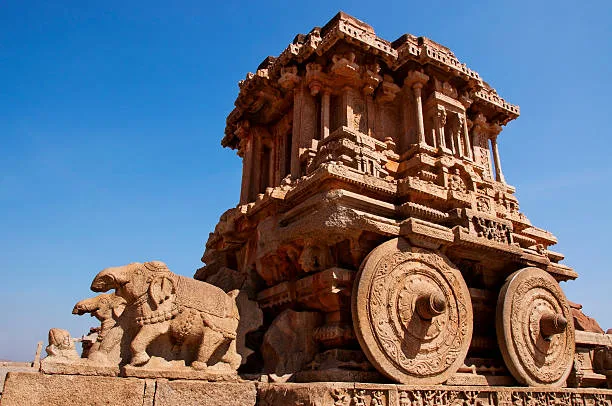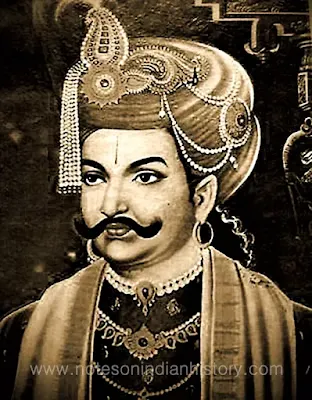The Rayas of Vijayanagar
The Vijayanagar kingdom emerged during the later years of the reign of Sultan Muhammad-bin-Tughlaq, and dominated southern India for more than two hundred years. Hampi, the erstwhile capital of the mighty Hindu kingdom, the Vijayanagar Empire, is one of the Unesco World Heritage Sites in India. Four successive dynasties ruled over Vijayanagar and they are: Sangama dynasty, Saluva dynasty, Tuluva dynasty and Aravidu dynasty. This post is about the rulers of the Vijayanagar empire. A king of Vijayanagar empire is known as Raya. Unlike Mughal emperors, the Rayas didn't appoint court historians to write the history of their reigns. Nor they wrote their own autobiographies or memoirs. We only have some inscriptions, Sanskrit and Telugu works, chronicles of Muslim writers and accounts of European travelers.
Rayas of the Sangama Dynasty (1336-1485):
Harihara I (1336-1354) - Founder of the Sangama dynasty
Bukka I, brother of Harihara I (1354-1379) - During his reign, in 1347, the Bahmani Kingdom emerged on the other side of the river Tungabhadra. Since then they were frequently at war with each other
Harihara II, son of Bukka I (1379-1404)
Bukka II, son of Harihara II (1404-1406)
Deva Raya I, brother of Bukka II (1406-1422) - During his reign, Firuz Shah Bahmani invaded Vijayanagar and he was compelled to give his daughter in marriage to Firuz.
Vira Vijaya, son of Deva Raya I (1422-1423)
Deva Raya II also known as Praudha Deva Raya (1424-1446), son of Vira Vijaya. During his reign, the Persian ambassador Abdur Razzak visited Vijayanagar.
Mallikarjuna, son of Deva Raya II (1446-1465). He is also known as Immadi Deva Raya and Immadi Praudha Deva Raya
Virupaksha, nephew of Deva Raya II (1465-1485), usurped the throne after deposing Mallikarjuna. However, the legal heir to the throne was Rajasekhara, the son of Mallikarjuna. In the opinion of Dr. V. K. Bhandarkar, Mallikarjuna was forced to give up the throne to his cousin Virupaksha in 1465. Virupaksha was deprived of his throne for a short time by Rajasekhara. Again Virupaksha was triumphant, who continued to rule while Mallikarjuna and his son Rajasekhara lived in the southern extremities of the empire. Virupaksha was the last ruler of the Sangama dynasty.
Rayas of the Saluva Dynasty (1486-1505): It is supposed that Saluva Narasimha usurped the throne of Vijayanagar after deposing Virupaksha.
Saluva Narasimha (1486-1492) - Founder of the Saluva dynasty. Vijayanagar was often called as Narsinga, a name derived from 'Narasimha', by the Portuguese.
Immadi Narasimha, son of Saluva Narasimha (1493-1505). He is also known as Narasimha II and Dharma Raya. Vasco da Gama arrived India during his reign. However, the real ruler was his minister Tuluva Narasa Nayaka
Rayas of the Tuluva Dynasty (1505-1569):
Vira Narasimha also known as Bhujabala Narasimha, a son of Tuluva Narasa Nayaka (1505-1509), established the Tuluva dynasty.
Krishnadeva Raya, half-brother of Vira Narasimha (1509-1530). The empire reached its peaks of glory during the reign of Krishnadeva Raya. He established good trade relations with the Portuguese of Goa. He defeated Sultan Ismail Adil Shah of Bijapur in the battle of Raichur in 1520 and also defeated Prataparudra Gajapati of Orissa. He was a great scholar, a musician and a poet. He wrote the famous Amuktamalyada in Telugu. The famous Hazara Ramaswamy and Sri Krishna temples were built by him. He also built the city of Nagalapur in memory of his mother Nagala Devi.
Achyuta, half-brother of Krishnadeva Raya (1530-1542)
Kumara Venkatadri also known as Venkata I, son of Achyuta Raya (1542) - Venkata was soon assassinated by the regent Salakam Timma Raju. Salakam Timma Raju was afterwards put to death by Rama Raya.
Sadashiva, nephew of Achyuta (1542-1569) - During Sadashiva's reign Aliya Rama Raya, a son-in-law of Krishnadeva Raya, became the defacto ruler of Vijayanagar. Rama Raya was captured and beheaded by the Deccan Sultans in the battle of Talikota in 1565, which marked the decline of the great Vijayanagar empire.
Rayas of the Aravidu Dynasty (1569-1646):
Tirumala, brother of Rama Raya (1569-1571), shifted the capital to Penukonda and founded the Aravidu dynasty. He was the defacto ruler of the kingdom after Rama Raya's death, though he asecended the throne only after Sadashiva's death in 1569. He retired from the throne on account of old age and Sri Ranga was made the yuvraja in 1571.
Sri Ranga I, son of Tirumala (1572-1585)
Venkata II or Venkatapati II, brother of Sri Ranga I (1585-1614) - In the opinion of Father Heras, it was Venkata II, who murdered Sadashiva Raya, while some other historians states that Tirumala murdered Sadashiva and captured the throne for himself. Venkata shifted his capital to Chandragiri about 1592. He shifted the capital to Vellore around 1606. During his reign, Raja Wodeyar defeated Tirumala, the viceroy of Srirangapatna, and declared his independence from Vijayanagar. Since Venkata had no sons, one of his favorite queens adopted a son. She put forward claims in favour of the child with support of her brother Jaggaraya. But Venkata nominated his nephew Sri Ranga as his successor to the throne. Venkatapati Raya's death was followed by a civil war, which further weakened the kingdom.
Civil War (1614-1618)
Sri Ranga II, nephew of Venkata II (1614) - Ranga II was deposed and murdered by Jaggaraya, within a few days of his accession.
Ramadeva also known as Rama II, son of Sri Ranga II (1614-1630?)
Peda Venkata also known as Venkata III, cousin of Ramadeva (1630?-1642)
Sri Ranga III, nephew of Peda Venkata (1642-1646) - The last king of Vijayanagar empire was a great grandson of Aliya Rama Raya.
Rayas of the Sangama Dynasty (1336-1485):
Harihara I (1336-1354) - Founder of the Sangama dynasty
Bukka I, brother of Harihara I (1354-1379) - During his reign, in 1347, the Bahmani Kingdom emerged on the other side of the river Tungabhadra. Since then they were frequently at war with each other
Harihara II, son of Bukka I (1379-1404)
Bukka II, son of Harihara II (1404-1406)
Deva Raya I, brother of Bukka II (1406-1422) - During his reign, Firuz Shah Bahmani invaded Vijayanagar and he was compelled to give his daughter in marriage to Firuz.
Vira Vijaya, son of Deva Raya I (1422-1423)
Deva Raya II also known as Praudha Deva Raya (1424-1446), son of Vira Vijaya. During his reign, the Persian ambassador Abdur Razzak visited Vijayanagar.
Mallikarjuna, son of Deva Raya II (1446-1465). He is also known as Immadi Deva Raya and Immadi Praudha Deva Raya
Virupaksha, nephew of Deva Raya II (1465-1485), usurped the throne after deposing Mallikarjuna. However, the legal heir to the throne was Rajasekhara, the son of Mallikarjuna. In the opinion of Dr. V. K. Bhandarkar, Mallikarjuna was forced to give up the throne to his cousin Virupaksha in 1465. Virupaksha was deprived of his throne for a short time by Rajasekhara. Again Virupaksha was triumphant, who continued to rule while Mallikarjuna and his son Rajasekhara lived in the southern extremities of the empire. Virupaksha was the last ruler of the Sangama dynasty.
Rayas of the Saluva Dynasty (1486-1505): It is supposed that Saluva Narasimha usurped the throne of Vijayanagar after deposing Virupaksha.
Saluva Narasimha (1486-1492) - Founder of the Saluva dynasty. Vijayanagar was often called as Narsinga, a name derived from 'Narasimha', by the Portuguese.
Immadi Narasimha, son of Saluva Narasimha (1493-1505). He is also known as Narasimha II and Dharma Raya. Vasco da Gama arrived India during his reign. However, the real ruler was his minister Tuluva Narasa Nayaka
Rayas of the Tuluva Dynasty (1505-1569):
Vira Narasimha also known as Bhujabala Narasimha, a son of Tuluva Narasa Nayaka (1505-1509), established the Tuluva dynasty.
Krishnadeva Raya, half-brother of Vira Narasimha (1509-1530). The empire reached its peaks of glory during the reign of Krishnadeva Raya. He established good trade relations with the Portuguese of Goa. He defeated Sultan Ismail Adil Shah of Bijapur in the battle of Raichur in 1520 and also defeated Prataparudra Gajapati of Orissa. He was a great scholar, a musician and a poet. He wrote the famous Amuktamalyada in Telugu. The famous Hazara Ramaswamy and Sri Krishna temples were built by him. He also built the city of Nagalapur in memory of his mother Nagala Devi.
Achyuta, half-brother of Krishnadeva Raya (1530-1542)
Kumara Venkatadri also known as Venkata I, son of Achyuta Raya (1542) - Venkata was soon assassinated by the regent Salakam Timma Raju. Salakam Timma Raju was afterwards put to death by Rama Raya.
Sadashiva, nephew of Achyuta (1542-1569) - During Sadashiva's reign Aliya Rama Raya, a son-in-law of Krishnadeva Raya, became the defacto ruler of Vijayanagar. Rama Raya was captured and beheaded by the Deccan Sultans in the battle of Talikota in 1565, which marked the decline of the great Vijayanagar empire.
Rayas of the Aravidu Dynasty (1569-1646):
Tirumala, brother of Rama Raya (1569-1571), shifted the capital to Penukonda and founded the Aravidu dynasty. He was the defacto ruler of the kingdom after Rama Raya's death, though he asecended the throne only after Sadashiva's death in 1569. He retired from the throne on account of old age and Sri Ranga was made the yuvraja in 1571.
Sri Ranga I, son of Tirumala (1572-1585)
Venkata II or Venkatapati II, brother of Sri Ranga I (1585-1614) - In the opinion of Father Heras, it was Venkata II, who murdered Sadashiva Raya, while some other historians states that Tirumala murdered Sadashiva and captured the throne for himself. Venkata shifted his capital to Chandragiri about 1592. He shifted the capital to Vellore around 1606. During his reign, Raja Wodeyar defeated Tirumala, the viceroy of Srirangapatna, and declared his independence from Vijayanagar. Since Venkata had no sons, one of his favorite queens adopted a son. She put forward claims in favour of the child with support of her brother Jaggaraya. But Venkata nominated his nephew Sri Ranga as his successor to the throne. Venkatapati Raya's death was followed by a civil war, which further weakened the kingdom.
Civil War (1614-1618)
Sri Ranga II, nephew of Venkata II (1614) - Ranga II was deposed and murdered by Jaggaraya, within a few days of his accession.
Ramadeva also known as Rama II, son of Sri Ranga II (1614-1630?)
Peda Venkata also known as Venkata III, cousin of Ramadeva (1630?-1642)
Sri Ranga III, nephew of Peda Venkata (1642-1646) - The last king of Vijayanagar empire was a great grandson of Aliya Rama Raya.





i have doubt abt ur article
ReplyDeleteThese are some really interesting facts about Vijayanagara Kingdom. Thanks a lot for sharing this information. I like collecting coins and was reading up about their coinage on websites like mintage world, when I happened to read your article!
ReplyDeleteI was doing a project (12th grade history project ) and this was one of the most informative and interesting articles on the same. Thank you so much.
ReplyDeletei want to know the name of the
ReplyDeleteraya in the first page please tell me